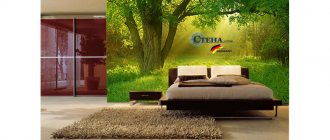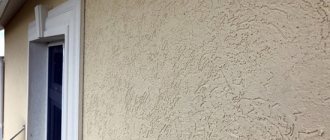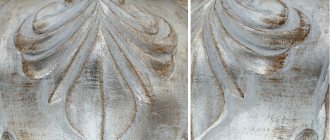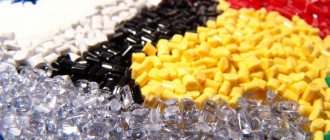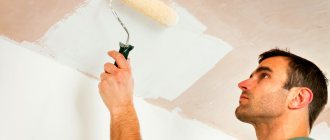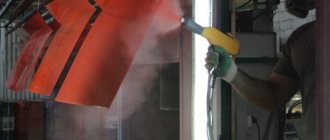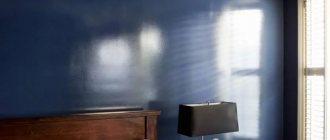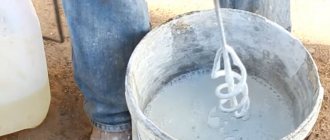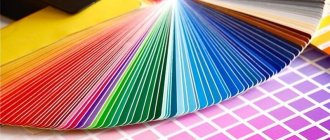Wood is popular as a building material. Furniture and many interior items are made from it. But since it needs protection from rodents, insects, and weather conditions, it must be properly processed.
Among other species, pine is distinguished by its reasonable price and beautiful texture. For these two reasons, it is it that is most often used for the manufacture of stairs. In order for a wooden structure to become even more beautiful and serve for many years, you need to figure out how to properly treat it, which varnish is best for a pine staircase.
What problems arise during varnishing?
Applying paints and varnishes to wood is significantly different from coating metal. At the same time, processing pine has its own difficulties.
- Wood is hygroscopic. Varnish and paint are absorbed by the wooden surface.
- When varnishing, the top layer of wood is moistened. The result will be raised lint or a rough surface.
- Pine stands out for its resin content. The resin does not penetrate the material evenly. It is difficult to paint a resinous surface, and not all paint adheres. The varnish covers the surface of the pine unevenly. To hide such a defect, it is recommended to apply a dark varnish.
Useful video on the topic:
Types of varnishing
Among all paint and varnish materials, there are 2 main ones: transparent and opaque. Experts recommend using transparent varnish if the wood is free of any defects. Most often, wood species are chosen that have a characteristic pattern:
- exotic trees;
- beech;
- oak.
Wood tinting.
If there are minor defects, but the wood is otherwise excellent, you can coat it with a primer to hide them. Before application, you should make sure that the surface is clean and dry so that the finishing is done as efficiently as possible.
The staircase is coated with clear varnish.
If the defects are large and cannot be hidden, for example, in pine, then you need to cover it with an opaque varnish. Typically a second coat is applied on top of the first to achieve the desired effect. Do not apply varnish if the wood has been covered with another material.
The staircase is coated with opaque varnish.
First of all, you should clean the surface of previous varnish coatings, dirt or nails, apply several layers of primer with a brush or spray, and only then can you proceed to the finishing stage.
Always wear protective masks when working with a spray bottle.
Which coating is best for pine
A beginner in carpentry may wonder what to choose for coating: staircase varnish or enamel. It may be easier to treat the entire structure with stain or stop at applying impregnation.
One stain will not be enough to treat a pine surface. As a coating, it does not provide a barrier to moisture penetration. The tree becomes loose over time. For pine, stain is a material for tinting. It penetrates into the wood, emphasizing the texture. Even if the varnish coating is worn out, the stain will help preserve the color of the entire wooden structure for a long time.
You can protect pine from moisture penetration and other unfavorable phenomena by impregnation. But staircase oil and wax coating are not able to protect steps from mechanical damage. On steps treated only with oil or wax, walk only barefoot or in slippers. Impregnation is used as an antiseptic and fire retardant.
If a wooden staircase is made of low-grade wood, then the top layer is enamel. It masks putty knots and cracks. The coating tolerates mechanical damage. Heavily diluted enamel can also emphasize the pattern on the surface. In this case, this layer is treated as a shading. At the finish, varnish is applied in 2 layers. In this case, all preliminary work on preparing the wood is carried out in strict sequence: cleaning, puttying, priming.
You can transform a staircase made of pine without defects by choosing varnish for processing. It will give the appearance a nobility, highlighting a beautiful textured pattern. Pine that is too light is tinted with varnish.
Stair processing
Before applying varnish, the wooden staircase must be treated. It is dried, fumed, sanded and polished. Before applying the varnish, impregnation and priming are carried out. This will help protect the pine from mold, mildew, and insects. The varnish is applied with a brush, roller or spray.
Some people prefer the natural color of wood, while others prefer painting. In this case, it is best to varnish the painted elements.
The stairs can be painted either before installation or after it. It is better to varnish an already assembled structure.
Coatings are usually applied in three layers, but polyurethane varnish can be applied in six layers. Particular attention should be paid to steps and handrails, as they bear a large load during operation.
Criteria for choosing varnish material
The staircase structure consists of the working surface of the steps and other parts. These two main components experience different loads.
The steps are subject to wear load. If the protective layer on their surface is weak, then the heels will leave marks. This is because pine is characterized by low wood density.
Handrails, the back of steps, and fittings are practically not subject to load. Therefore, the applied varnish for the stairs in this case will perform decorative and protective functions (from moisture and rotting).
Varnish for pine stairs is selected based on the following functional division of the main elements:
- To cover the steps, polyurethane parquet varnish for wooden stairs is used. It forms a durable coating with a high degree of wear resistance. The material is expensive. It is used to create a protective and decorative layer.
- The answer to the question of which varnish to choose for stair steps in order to hide signs of wear in their central part is very simple - it is a matte or semi-matte varnish. The matte surface does not slip, which makes the staircase structure safe. The worn-out gloss on the steps spoils the appearance.
- Fittings or elements that are not subject to stress are treated with an inexpensive nitrocellulose varnish composition NTs, the second option is alkyd PF-170.
For coniferous species, special LM are selected due to the fact that the fibers have increased resin content.
The work uses 4 types of varnish:
- The composition, based on alkyd resins, is anhydrous. It copes with changes in humidity and temperature fluctuations. Penetrates deeply into wood. Applied as a decorative coating. Wears out quickly. Used to cover stairs indoors and outdoors.
- Water-based composition – water soluble. It is applied after a layer of primer. The material is odorless, environmentally friendly. To process the stairs, a two-component composition is used. If one of the elements is a solvent, then the coating will be durable.
- Treatment of stairs inside the house - varnish with an oil base.
- The most durable composition is acid-curing. It is applied to areas with heavy load.
For staircase structures on the street, it is recommended to use LM for yachts. It is also used indoors. Its main advantage is its tolerance to atmospheric influences and low temperatures. In houses without permanent residence, a yacht composition is preferable.
A correctly selected varnish will perform a protective or decorative function. If all technological stages of applying the material are followed, then as a result a pine staircase will become a decoration of the house and will be used for many years.
What varnish should I use to coat the steps of the stairs?
In order to answer this question, you need to understand what varnishes exist and how they differ? Let's consider only those that are used in our work in the manufacture of steps for stairs and other wooden elements used in their installation.
Varnishes can be divided into groups according to:
- basis (varnish composition, chemical composition);
- purpose;
- method of application;
- appearance (transparent or with toners added to them);
- degree of gloss.
According to the chemical composition, varnishes are:
- water based;
- polyurethane;
- acrylic.
There is also a separate type of coating - oil (mastic). There are more varnishes than listed, but we repeat, we are not considering all varnishes, but only the most common ones that can be used in the manufacture of stairs.
When choosing a coating for steps, pay attention to varnishes specifically designed for this purpose. As a rule, they have an indication of the manufacturer: parquet varnish, varnish for stairs.
Household varnishes
For use in the home, water-based varnishes are most convenient to use. They have average abrasion resistance. Low toxicity allows them to be applied in residential areas. They are safe, since the solvent is water, and there is no fear that an accidental spark will cause a fire.
An important factor is the ease of applying the varnish. Water-based varnishes do not require highly qualified painters or special equipment.
- Brush - for working in hard-to-reach places.
- Parquet brush - for applying varnish to parquet.
- Varnish spatula - allows you to disperse the applied varnish along the plane.
- A roller is the most correct and convenient tool for applying water-based varnish. High productivity and the ability to work while standing, which, you see, is important in itself.
The disadvantage of this varnish is its not very high durability and transparency, as well as the appearance of the coating itself. Wood treated with this product appears a little milky. But if you are doing the work yourself, then a water-based varnish will most likely be the best choice for a DIYer.
In addition, if over time there is a need to renew the coating, this should be done with varnish with the same base that was originally covered. This is done relatively simply and the best part is that there is no toxic atmosphere, which means you don’t have to carefully close the room where the work was carried out.
The low density of water-based varnish allows it to be applied in a thin layer, which is sometimes used by unscrupulous workers - three layers in 40 minutes. Only such a coating will not last very long, so the layers must be sufficient.
Pay attention to the product consumption indicated by the manufacturer. Do not be afraid of the high consumption of varnish on the first layers; in subsequent layers it will decrease significantly.
But if you want to achieve the best result: high strength and transparency, then you should pay attention to polyurethane varnishes.
They come in one-component and two-component types - they differ in the varnish base. The application method is slightly different from water-based varnishes due to lower fluidity and increased density. But high toxicity limits their use in everyday life, so such products are more widely used in the professional field, but the truth is that they will be slightly different varnishes.
Professional varnishes
Professional varnish is a product that can be applied under certain production conditions and requires special skills from the worker. And in our work it’s both.
These varnishes can no longer be used at home, but due to the fact that the result obtained is much better than that of the products listed above, we use them in the manufacture of wooden steps and other elements of stairs. Let us tell you a little about their features.
What do these varnishes provide from a consumer point of view?
- High wear resistance. This is achieved by the chemical composition of the varnish and the precise selection of its components, including at the stage of preparation for application.
- Appearance. Varnishes have high transparency and quality of paint coating due to the method of applying the varnish.
The coatings are very toxic and are applied by spraying. Therefore, all work takes place in special chambers with powerful hoods. And yet, the master has to work in a mask with filters that can clean the incoming air from very aggressive solvents.
The peculiarity of applying varnishes is due to the high qualifications of the painter and, accordingly, his high salary, plus the cost of the varnishes themselves, which cannot but affect the final cost of the work. As a rule, painters who work with such products are present at enterprises and have a high workload for this work.
Considering the specific nature of the work, varnish manufacturers do not supply them to stores; packaging (buckets or barrels) requires a large amount of work.
The varnishes discussed use two bases: acrylic or urethane. urethane coatings are more used acrylic ones , since they are cheaper, but over time they will yellow somewhat.
For most cases, this does not matter, there are exceptions - for example, if your steps are made using whitening technology, then a slight change in shade towards yellow will be undesirable.
In these cases, it is better to use acrylic-based varnish; you should also keep in mind that the packaging of the varnish will most likely be purchased exclusively for you, and this will affect the cost of the work.
Gloss level
The degree of gloss of a varnish is measured in % or, as it is also indicated, “gloss”, which actually translates as shine.
According to the degree of gloss, varnishes are:
- High gloss - more than 91%
- Glossy - 71 - 90%
- Semi-gloss - 51-70%
- Semi-matte - 31-50%
- Matte - less than 11 - 30%
- Deep matte - less than 10%
When choosing a coating, look at samples and try to remember what the varnish looks like with varying degrees of gloss. This will greatly help when comparing products from different manufacturers. The comparative descriptions (terms) of companies differ, sometimes significantly, but the numbers obtained on a special device reflect this less subjectively.
In our practice, we use varnishes with a gloss level of 30%. The most accurate description for this grade is silky shine. This coating is not too shiny and looks neat. It is not so matte and does not cause a feeling of unkemptness during use. A clear example is smartphone cases. Remember how easily fingerprints and greasy marks are visible on glossy or matte surfaces. In the case of steps, everything is very similar. It is better to use varnish with a gloss of 30%.
Source: https://slio-spb.ru/informaciya/stati/kakim-lakom-pokryt-stupeni-lestnitsy/
Recommendations for choosing colors
When choosing a shade of paint and varnish, consider:
- lighting - light colors are appropriate on a dark staircase. Dark tones in the light will highlight the wood grain. In the light of the sun or lamps, the gloss will reflect unpleasantly, so for a lit staircase it is better to choose a matte finish;
- color combination - the color of the stairs matches the color of the walls, baseboards, doors, floor;
- style - in classics, a light staircase is combined with a dark floor, in high-tech - white steps and gray risers - with black railings. Combinations of matte and gloss also convey the character of the interior. Warm, sunny shades and gloss are suitable for country music, and a matte surface is suitable for minimalism;
- density of wood - since during painting pine can show its southern temperament in the form of spots, it is better not to take risks and choose a light coating or clear varnish.
The traditional combination is varnished steps, railings and painted risers. Balusters can be painted or varnished as desired. Classic shades of paint - white, beige, peach, olive. Unusual color scheme - white steps and red railings.
Magnificent finished stairs from our company
You can, of course, make a wooden staircase yourself, and then paint it as you wish. But it is much easier and more profitable to purchase a ready-made staircase structure from the best professional craftsmen.
You can purchase finished wood with a high-quality varnish coating for just 75 136
rubles
The staircase system from the “Prestige” series with beautiful wooden steps has a cost 44 290
rubles
Our systems are distinguished by high quality, reliability, safety and excellent appearance. And for their coloring we use the best durable and environmentally friendly compounds.
But such a modern and stylish system will cost you 115 814
rubles
The design model of a rotating type with steps made of natural wood has a price 120 000
rubles
Dyeing technology
Painting a wooden staircase takes place in 2 stages. This is preparing the base and, directly, opening the railings, balusters, and steps with varnish or paint. The first stage is very important; you cannot do without it if you want to get a beautiful and smooth staircase.
Preparing the base
To work, you will need a solution for removing old paint, wood putty or alternative methods of sealing cracks (wood chips, wood dust mixed with colorless varnish), an antiseptic primer, an iron brush, a spatula, sandpaper - 80, 100, 120, 180 - 220 , 240 – 320 and zero.
The technology for preparing the base with your own hands is simple:
- Remove debris from the stairs and wash them with water. Then wait until it dries completely.
- Treat the steps with old paint remover. Using a spatula, remove the swollen coating. Remove what hasn't risen with an iron brush.
- Clean the steps, balusters and railings with sandpaper, or preferably two – first 80-grit, then 100-grit, remove dust with a brush, and vacuum the steps additionally.
- Seal the cracks. The putty will not last long if the stairs are actively used. Try sealing the cracks with wood chips. Select a piece according to the size of the hole, coat it with PVA glue and place it in place. Another way to seal cracks: mix wood dust with colorless varnish, seal the cracks with the resulting composition and let dry.
- Go over it again with 120-grit sandpaper, remove the dust and finish the job with sandpaper. Ideally, the steps, balusters, and railings should be smooth “like an egg.”
- Treat the stairs with an antiseptic primer. Use a roller for this. Make sure that the composition gets into all the recesses and decorations (if any).
- Wait for the primer to dry.
Now you can begin the final stage.
Paint coating
This is a crucial moment. The quality of the coating determines the appearance of the staircase and how harmoniously it fits into the interior of the house. To work you will need paint and a brush/roller. You can use a spray gun (it costs significantly more than conventional tools for applying paintwork).
DIY paint application technology:
Open the jar. Using a long, strong wooden stick, stir the paint thoroughly. There should be no lumps in it. If the composition is excessively thick, dilute it with a solvent. Dip your brush or roller into the paint. Start painting. All movements should be along the fibers. After priming, the paint should not be absorbed too quickly. If you notice that the composition goes into the wood like a sponge, paint the entire staircase and wait until the first layer dries. Reapply paint
Pay special attention to the joints of the baluster/floor, baluster/railing, as well as various notches and squiggles (if there are shaped elements on the stairs).
Advice! After the paint has dried, open the stairs with clear varnish. This will increase the strength of the coating. As an option, paint only the steps, and varnish the balusters and railings.
Varnish coating
The preparatory work before such finishing is somewhat different. Sanding is carried out only once before the first opening. This is due to the fact that the varnish will inevitably raise all the fluff on the surface. Interlayer sanding will be required (180 - 220 sandpaper), and for the first layer it is better to use a special primer varnish.
Note. After stripping the primer varnish, the stairs are always a pitiful sight
It looks much worse than after removing the old paint. Don't be alarmed. A second coat of varnish, applied to a properly prepared surface, will do the trick.
Painting the stairs is carried out in steps:
- Prepare a clear varnish (if it is two-component, mix it with your own hands according to the instructions).
- Dip a velor roller into varnish.
- Start coating by running the roller along the grain of the wood.
- Let the layer dry. This is approximately 3 hours.
- Do another intercoat sanding. Use fine sandpaper (240 – 320).
- Apply a second coat of varnish. The third or more layers are applied only after the previous one has completely dried.
If you don’t like the natural color of pine, larch or other wood, use stain to make the stairs darker. You can use an oil-based varnish. choosing the right shade. It's up to you to decide which is better.
The drying time for the staircase depends on the number of layers of varnish. After a day, you can walk along it in socks or knitted slippers without hard soles. On average, the coating gains working strength in 7 - 10 days. In order to tidy up the staircase with your own hands and not spoil its appearance, you must have minimal skills in working with paints and varnishes. Follow the instructions exactly, and then the result will meet your expectations.

